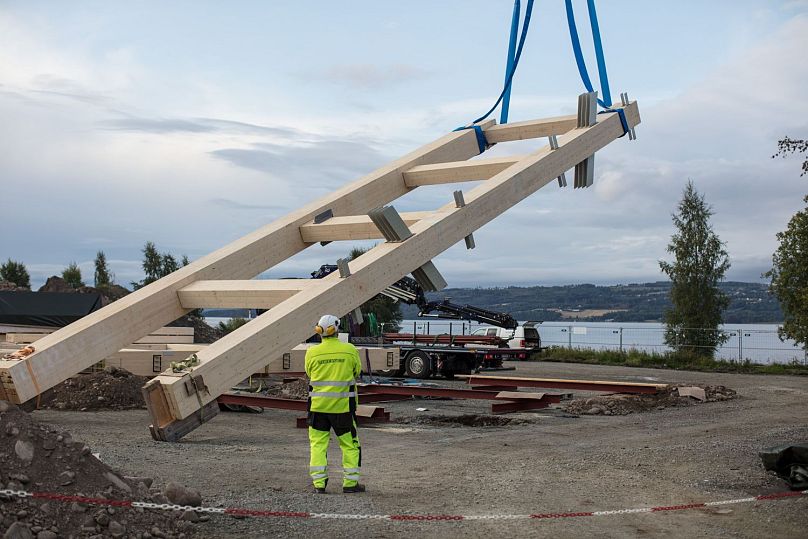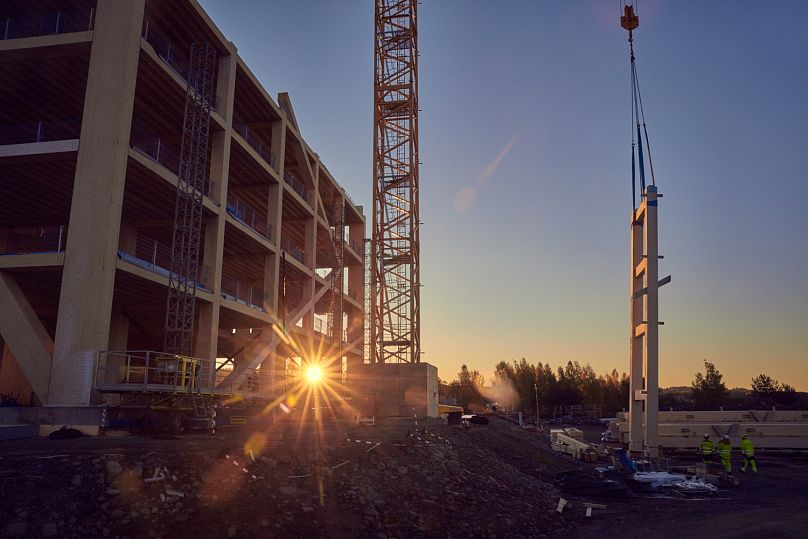Timber is set to become a popular alternative to traditional building materials used in tall buildings, says Rune Abrahamsen, a timber expert who is helping to construct the world's tallest wooden high-rise in Norway.
Rune Abrahamsen developed an interest in timber as a student during the 1994 Winter Olympics in Lillehammer, Norway. While most spectators were watching the action on the arena floor, he says, his gaze was fixed on the timber ceiling, fascinated that such huge structures could be made from wood.
More than 20 years on, Abrahamsen is part of a team constructing an 18-storey wooden tower that will be the world’s tallest timber building when it’s finished in March 2019. Located in the small Norwegian town of Brumundal, the 80-metre-high Mjøstårnet building will house a hotel, offices, apartments, and restaurants, with a swimming hall attached.
Abrahamsen’s company supplies the timber used in the building: a flexible, durable material called glulam, which is made from wood that has been planed (or smoothed) and glued together to form strong columns and beams.
Abrahamsen spoke to Euronews about why timber is set to become a popular alternative to traditional building materials in high-rise structures.
What are the advantages of using timber for tall buildings?
Timber is strong and it’s light, which reduces the cost of the foundations. Building with timber is faster -- all components are prefabricated, so building with timber is more or less like building “Lego.” You bring in large parts that you connect and install on site. So you can assemble buildings on site very quickly.
Timber has extreme precision, meaning that when we manufacture and process these large glulam members in our factory, they are less than one millimeter out of theoretical geometry. (The more precise the joins, the stronger the structure is.) So we have very good precision compared to concrete, but also similar or better precision than what you can expect from a steel structure.
Timber is produced from a renewable source, stores carbon and is generally a climate-friendly choice of material. You also get a clean building site. There is little dust and little noise from cement mixers, so it makes for a good working environment. These are just some of the many advantages.
Why isn't fire hazard a problem?
Timber burns, but the good thing is that we know how it burns. You can imagine a big log that you put on the fire in the woods when you’re out camping. The small branches that you put around this big log will burn down completely overnight, but the big log will still be there in the morning because there is nothing around it to keep it burning. Similarly, a timber building will remain standing after a fire has gone out by itself. The charring of wood creates an insulating layer that protects the inner part of the timber. The charring speed is predictable. Large cross sections of glue-laminated timber will have a considerable cross section of undamaged wood after a fire has ended, and this remaining cross section can carry the load.
How does this differ to the behaviour of concrete and steel in a fire?
In general, timber has a better bearing capacity. When there is a fire, concrete will get warm and crack, which means there will be openings at the surface, exposing the reinforcement. The reinforcement is normally made of steel and when the steel gets warm it melts and loses its bearing capacity. Consequently, the concrete will collapse because it’s no good without the reinforcement.
What are the biggest challenges when using timber?
Many contractors, builders, engineers and architects have limited experience in using timber for large buildings. Timber is light, and in some cases this is challenging when it comes to vibrations and acoustics. For tall timber buildings, it is economical to address this by adding mass to the upper part of the structure or to build hybrid buildings (that is, a timber-concrete composite building). For Mjøstårnet, we have a main load-bearing in timber with some of the decks in concrete in the upper levels, resting on the timber structure. We introduced that to have an extra weight in the building to reduce the “swaying” from the wind for people staying in the upper areas.
Is it a lot more expensive to use wood compared to steel and concrete?
It used to be more expensive. But if you can plan on using timber from the very beginning of the project so that you can optimise it for wood and timber solutions, you can get a competitive price for load-bearing structures.
Are tall wooden buildings a novelty, or do you expect it to become a standard material in skyscrapers?
I think it will become an alternative material for tall buildings. It will not be the material used to build the next tallest skyscraper in the world, at least not for the next few decades, but it will be an alternative for buildings reaching 100 to 200 meters.
What can governments do to encourage the construction of timber buildings?
They can have public buildings made out of wood, but they can also provide rules saying that builders (public and private) should go to some length to try to find a timber solution before they continue with other solutions. This has already been done in Canada, in British Columbia, where the provincial government has a rule called the Wood First Act saying that all public buildings should primarily be made out of wood, and you need to prove that it’s not suitable to use wood before you can use conventional materials.
When is a structure classified as a timber building?
There’s a proposed definition for this on the table, and it comes from the Council on Tall Buildings and Habitat (CTBUH). The definition says that the load-bearing system needs to be made out of a single material (in this case wood) for it to be called a wooden or timber building. This means you need to have all columns, beams, diagonals, and floors out of one material. But there is an exception: you are allowed to have decks out of another material as long as they’re resting on the main material.
What are your company's biggest timber projects?
At present we are building the 18 storey Mjøstårnet building, which will be more than 80 m tall, and a new bank building in Stavanger called Finansparken Bjergsted. These two projects are similar in size. Historically the company’s biggest projects have been the arenas for the 1994 Winter Olympics in Lillehammer, the roof structure of Oslo Airport (OSL) and about 200 large timber bridges scattered around Norway.
What other tall timber building projects are you excited about around the world?
There are too many to mention, but here are some of them: the HoHo building in Vienna, Brock Commons – a student residence in Vancouver, Skellefteå cultural centre in Sweden, The Haut building in Amsterdam, and the Origine in Québec.
Rune Ambrahamsen is CEO of Moelven Limtre AS, a Scandinavian company that produces building materials for use in construction.













